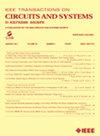一种0.0019 mm²lc环振荡器,带超紧凑变压器,实现175.2 dBc/Hz FoM@1MHz和202.4 dBc/Hz FoMA
IF 4
2区 工程技术
Q2 ENGINEERING, ELECTRICAL & ELECTRONIC
IEEE Transactions on Circuits and Systems II: Express Briefs
Pub Date : 2025-03-21
DOI:10.1109/TCSII.2025.3553716
引用次数: 0
摘要
本文介绍了一种具有超紧凑变压器谐振器的面积高效lc环振荡器。串联逆变器可以等效于提供增益补偿的负电阻。所涉及的逆变器和开关电容器组完全集成在变压器谐振器下面。因此,与典型环形振荡器的面积相当,我们的振荡器显示出显着改善的相位噪声(PN)和品质因数(FoM)。此外,我们还实现了基于堆叠耦合和分布式耦合变压器的lc环振荡器,用于PN和FoM的比较。叠置耦合lc环振荡器可以在相同频率和功率预算的情况下降低PN。我们的堆叠耦合LC-ring振荡器在40纳米CMOS中制造,在3.7至5.1 GHz的频率调谐范围内,${\mathrm {PN}}_{\unicode {0x0040}1{\mathrm {MHz}}}$为-110.4 dBc/Hz,有效面积为0.0019 mm2,对应于更高的FoM (FoMA) ${}_{\text {@1MHz}}$为175.2 dBc/Hz (202.4 dBc/Hz),比分布耦合LC-ring振荡器高4.2 dB (6 dB)。本文章由计算机程序翻译,如有差异,请以英文原文为准。
A 0.0019-mm² LC-Ring Oscillator With an Ultra-Compact Transformer Achieving 175.2 dBc/Hz FoM@1MHz and 202.4 dBc/Hz FoMA
This brief describes an area-efficient LC-ring oscillator featuring an ultra-compact transformer resonator. The series inverters could be equivalent to the negative resistors providing gain compensation. The involved inverters and switched-capacitor banks are fully integrated underneath the transformer resonator. Thus, with a comparable area of the typical ring oscillators, our oscillator shows significantly improved phase noise (PN) and figure-of-merit (FoM). Besides, we implemented the stacked-coupling and distributed-coupling transformer-based LC-ring oscillators for the PN and FoM comparison. The stacked-coupling LC-ring oscillator can lower the PN with the same frequency and power budget. Fabricated in 40-nm CMOS, our stacked-coupling LC-ring oscillator scores a ${\mathrm { PN}}_{\unicode {0x0040}1{\mathrm { MHz}}}$ of -110.4 dBc/Hz across the frequency tuning range from 3.7 to 5.1 GHz with an active area of 0.0019 mm2, corresponding to a superior FoM (FoMA) ${}_{\text {@1MHz}}$ of 175.2 dBc/Hz (202.4 dBc/Hz) that is 4.2 dB (6 dB) higher than the distributed-coupling LC-ring oscillator.
求助全文
通过发布文献求助,成功后即可免费获取论文全文。
去求助
来源期刊
CiteScore
7.90
自引率
20.50%
发文量
883
审稿时长
3.0 months
期刊介绍:
TCAS II publishes brief papers in the field specified by the theory, analysis, design, and practical implementations of circuits, and the application of circuit techniques to systems and to signal processing. Included is the whole spectrum from basic scientific theory to industrial applications. The field of interest covered includes:
Circuits: Analog, Digital and Mixed Signal Circuits and Systems
Nonlinear Circuits and Systems, Integrated Sensors, MEMS and Systems on Chip, Nanoscale Circuits and Systems, Optoelectronic
Circuits and Systems, Power Electronics and Systems
Software for Analog-and-Logic Circuits and Systems
Control aspects of Circuits and Systems.

 求助内容:
求助内容: 应助结果提醒方式:
应助结果提醒方式:


